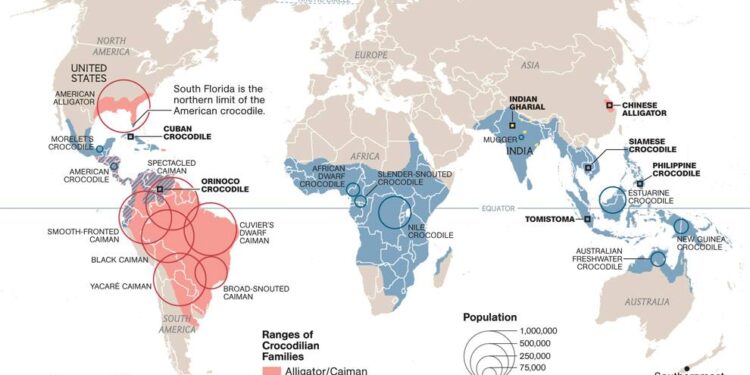In recent years, the economic ramifications of biological invasions have gained increasing attention from researchers and policymakers alike. As non-native species encroach upon ecosystems, they threaten not only biodiversity but also the very foundations of economic stability. A new study published in Nature seeks to bridge the knowledge gap surrounding the costs associated with these invasions by marrying species range data with macroeconomic indicators. By analyzing how invasive species impact local economies and ecosystems, the research highlights a pressing need for integrated approaches to manage and mitigate the far-reaching consequences of biological invasions. As the world grapples with environmental challenges exacerbated by climate change and globalization, understanding the financial toll of these ecological disruptions has never been more critical. This article delves into the findings of the study and explores its implications for conservation strategies and economic policy.
Integrating Species Range Analysis with Economic Data to Assess Invasion Costs
Recent research has highlighted the necessity of merging species range analysis with economic data to more accurately estimate the costs associated with biological invasions. This integration offers profound insights into how invasive species affect not just biodiversity but also local and national economies. The study underscores that the economic impact of these biological invasions can vary dramatically based on the species involved, the ecosystem affected, and the regional economic context. By overlaying species distribution models with macroeconomic indicators, researchers can identify priority areas for intervention to mitigate the financial burden of invasions.
Key findings of this analysis indicate the potential to categorize invasion costs into several impactful sectors, including:
- Agriculture: Crop damage and loss of yield due to invasive pests.
- Fisheries: Decreased fish populations leading to lower fishing revenues.
- Tourism: Decline in natural attractions due to ecosystem degradation.
- Public health: Increased healthcare costs from diseases spread by invasive species.
To better illustrate these economic impacts, the table below summarizes estimated costs associated with selected invasive species across different sectors:
| Invasive Species | Sector Affected | Estimated Annual Cost (in millions) |
|---|---|---|
| Asian Carp | Fisheries | $200 |
| Burmese Python | Tourism | $100 |
| Zebra Mussels | Agriculture | $500 |
| West Nile Virus | Public Health | $150 |
This multifaceted approach not only enhances our understanding of how invasive species impact economies but also informs policymakers in crafting effective strategies to reduce these costs. By taking into account economic data alongside ecological factors, we can prioritize resources and action plans to combat the ongoing threat of invasive species in a more economically efficient manner.
Identifying Key Metrics for Effective Management of Biological Invasions
Effective management of biological invasions hinges on the ability to pinpoint and analyze key metrics that reflect both ecological impacts and economic implications. By leveraging species range data alongside macroeconomic indicators, stakeholders can develop a comprehensive understanding of how invasions alter landscapes and economies. Some crucial metrics may include:
- Species Distribution Changes: Monitoring shifts in habitats occupied by invasive species can highlight the extent of their spread.
- Ecological Damage Estimates: Quantifying the loss of native species and alterations to local ecosystems can provide insight into biological ramifications.
- Economic Impact Assessments: Calculating the financial burden on agriculture, tourism, and fisheries assists in illustrating the broader economic consequences of invasions.
The synthesis of such metrics can lead to the development of predictive models, which serve as powerful tools for policymakers. By integrating risk assessments and cost-benefit analyses, agencies can prioritize management strategies for the most detrimental species. For example, the following table outlines potential invasive species alongside their estimated economic costs and ecological harm:
| Invasive Species | Estimated Economic Cost | Ecological Impact |
|---|---|---|
| Yellow Crazy Ant | $20 million/year | Disruption of crustacean populations |
| Asian Carp | $75 million/year | Threat to native fish species |
| Zebra Mussel | $1 billion/year | Clogging waterways, harming aquatic life |
Policy Recommendations for Mitigating Economic Impact through Proactive Invasion Strategies
The economic ramifications of biological invasions can no longer be overlooked, as they pose serious threats to both ecosystems and various sectors of the economy. To address these challenges effectively, policymakers must implement a series of proactive strategies. Among the most critical approaches are:
- Enhanced Risk Assessment: Establish comprehensive frameworks for evaluating the economic risks associated with potential invasive species, utilizing predictive modeling based on species range data and macroeconomic indicators.
- Targeted Investment: Allocate resources towards specific regions and sectors that are most vulnerable to invasions, ensuring funding goes to prevention, monitoring, and rapid response measures.
- Stakeholder Engagement: Involve local communities, industry representatives, and environmental organizations in the decision-making process to foster a collective approach to managing invasive species.
Further, collaboration between government agencies and research institutions is crucial to developing innovative solutions that mitigate economic impacts. This could include:
- Data Sharing Initiatives: Create platforms for sharing species range data, economic impacts, and invasive species trends among stakeholders to facilitate informed decision-making.
- Public Awareness Campaigns: Conduct outreach programs to educate the public on the economic risks associated with biological invasions and promote best practices in prevention and management.
- Legislative Actions: Enact regulations that support preventive measures, including stricter control over the importation of potentially invasive species.
Closing Remarks
the intersection of species ranges and macroeconomic data offers a promising avenue for understanding the true costs of biological invasions. As researchers continue to refine these methodologies, the implications for policymakers and conservationists are profound. By quantifying the economic impacts of invasive species more accurately, stakeholders can better prioritize resources and strategies for managing these threats to biodiversity and ecosystem health. The findings emerging from this innovative approach remind us of the urgent need to address biological invasions not just as ecological concerns, but as significant economic challenges that reverberate through communities and ecosystems alike. As we move forward, integrating these insights into effective policy and management will be crucial in safeguarding our natural heritage and mitigating the far-reaching consequences of invasive species.






























